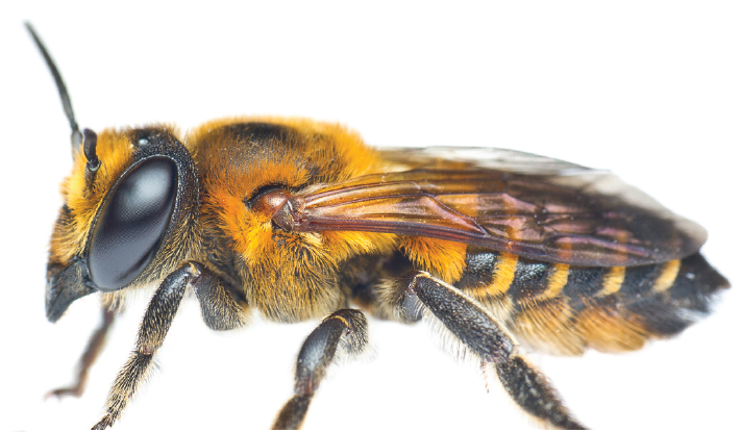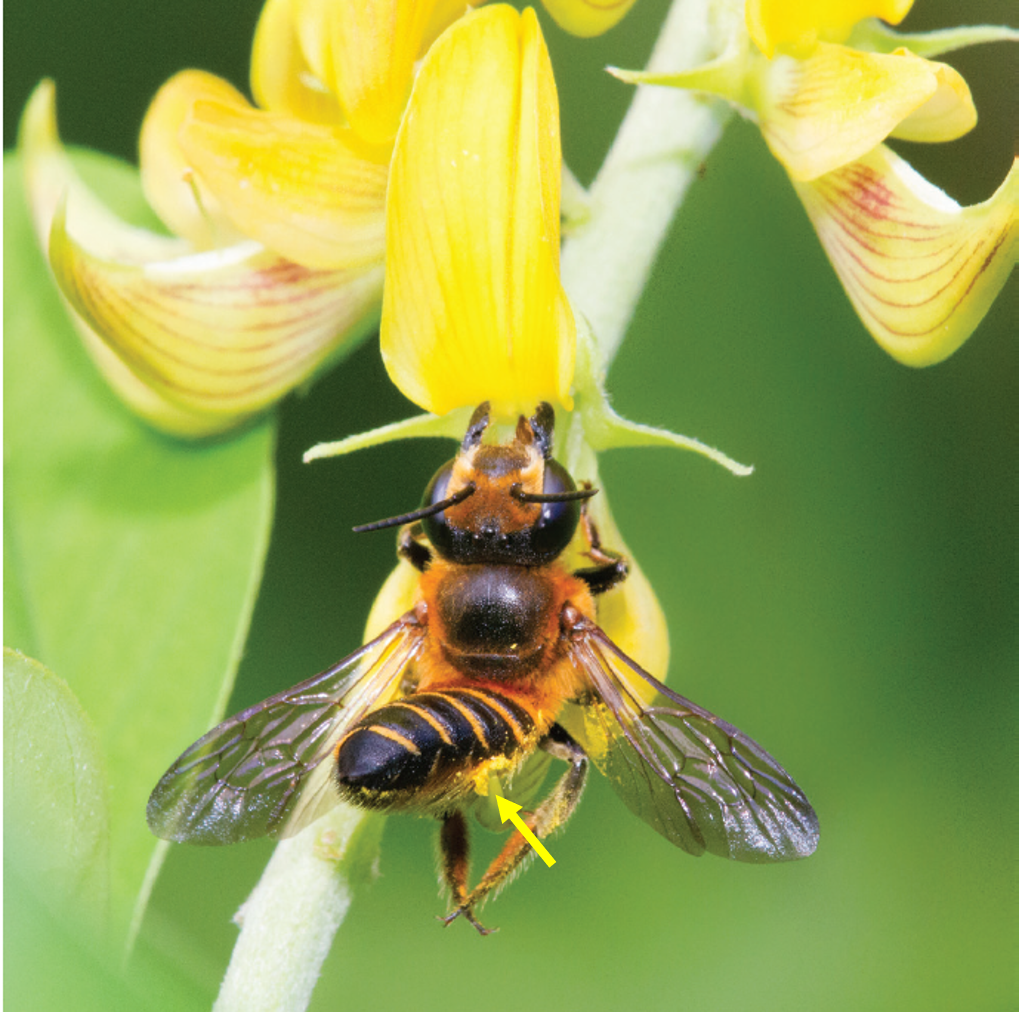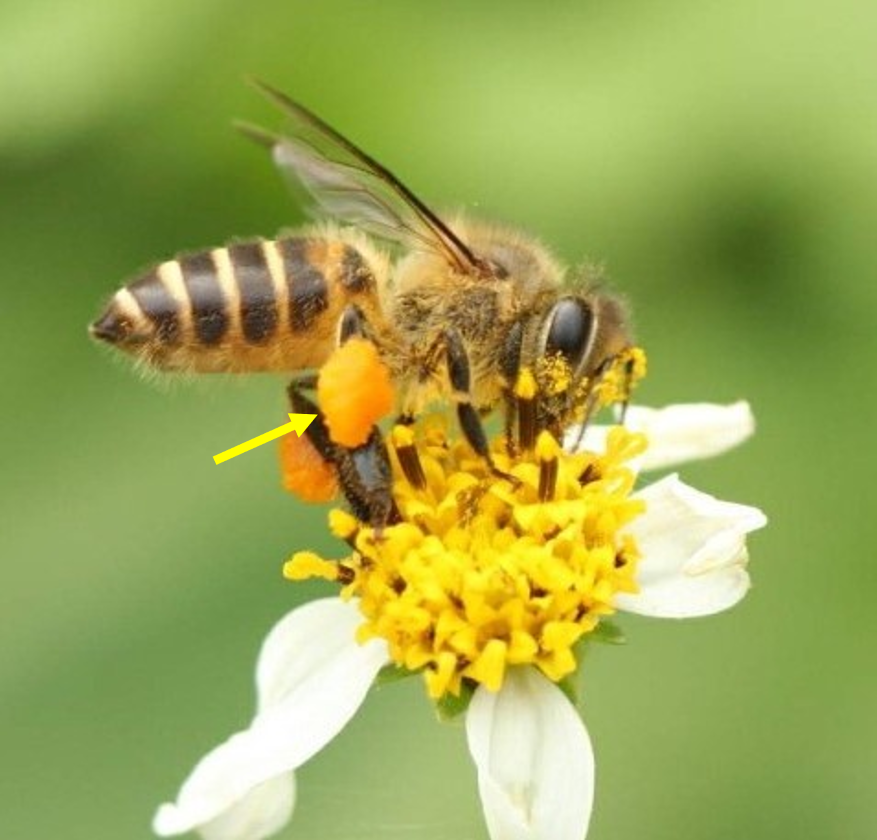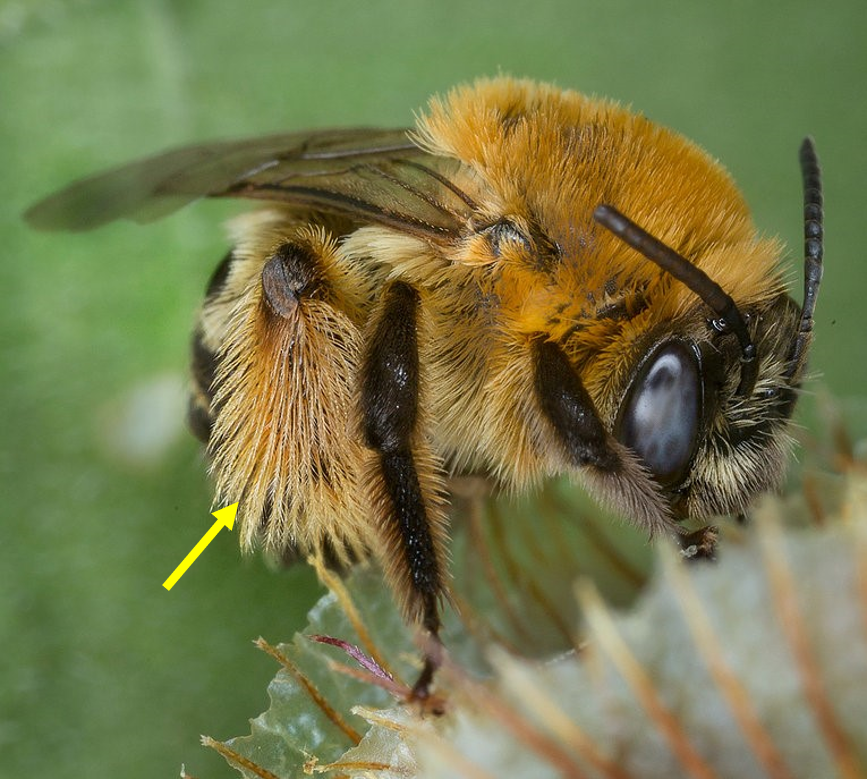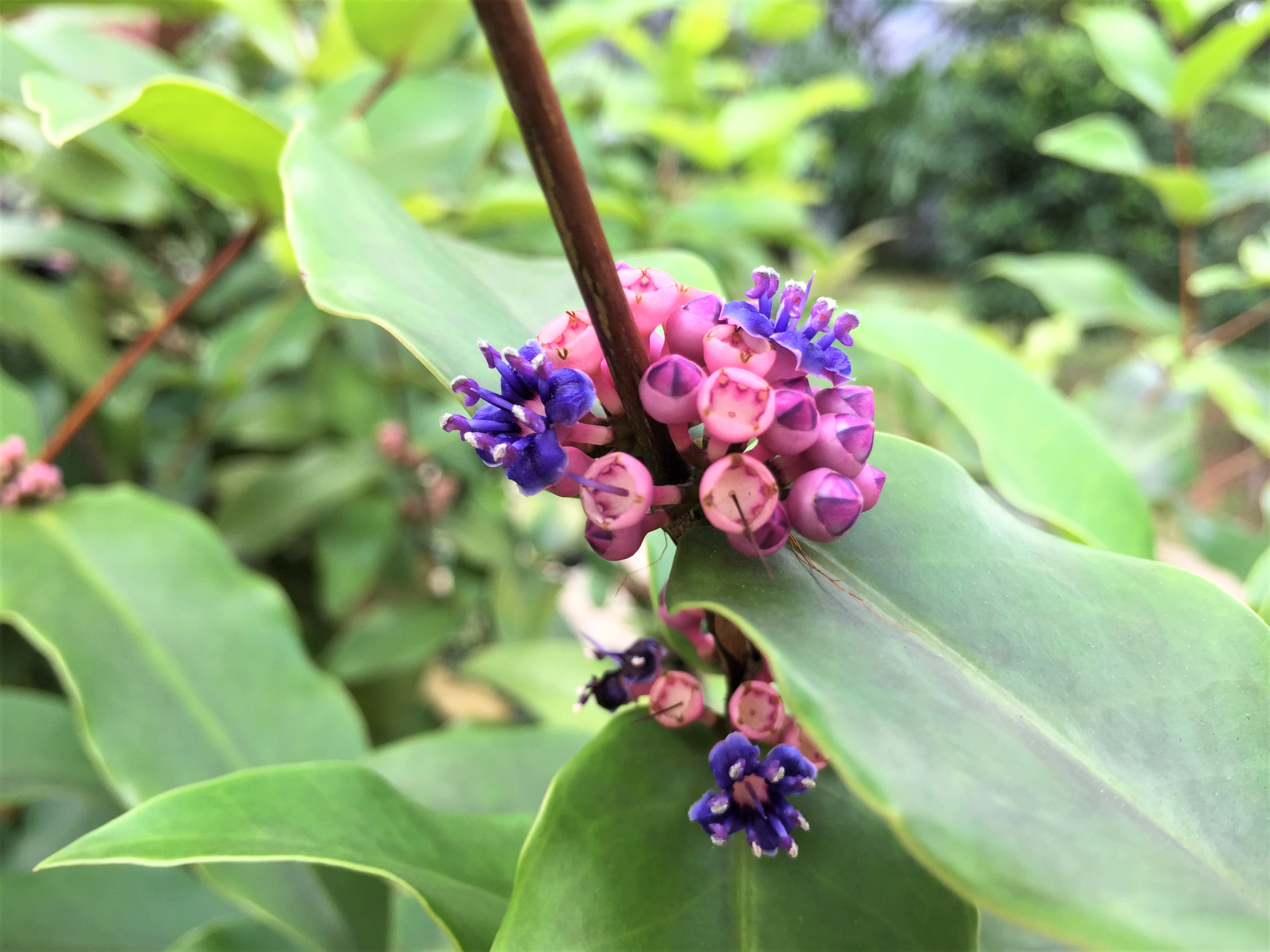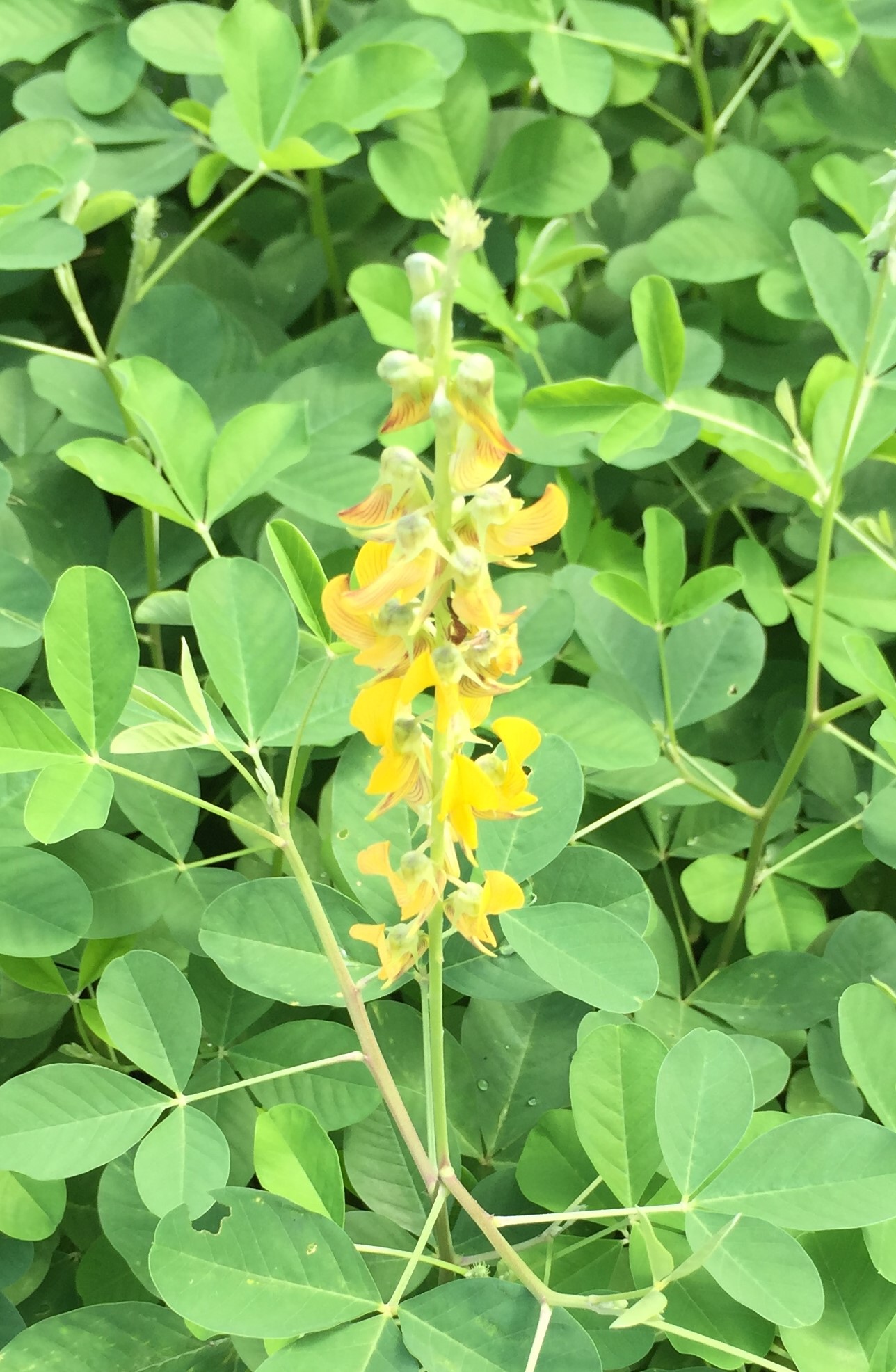Leaf-cutter Bee
Megachile (Aethomegachile) laticeps, Smith 1853
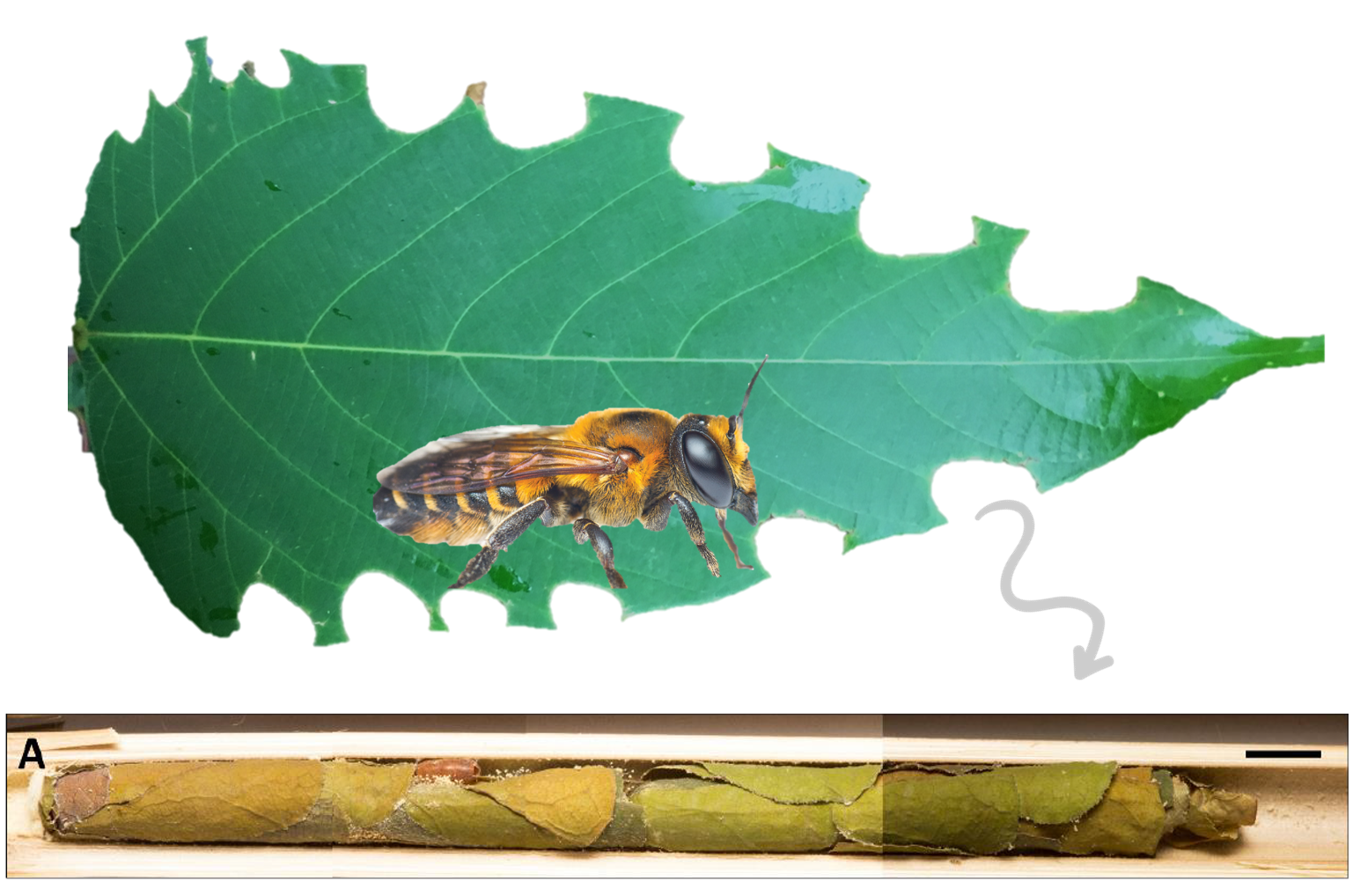 |
| Figure 1. Leaf damage caused by a leaf-cutter bee, which uses leaves to build a nest (images not to scale). Leaf image by Sebastian Ow; bee image from Ascher et al. (2016) [1]; nest image by Eunice Soh [2]; all images used with permission. |
Cut leaves are common wherever you look, and the first thought that comes to your mind might be that they are caused by grasshoppers or caterpillars. However, not all cuts are as typical as they seem - they could be caused by leaf-cutter bees!
What is a Leaf-cutter Bee?
The name Leaf-cutter Bee, when put together, may seem strange at first. After all, what do bees have anything to do with leaves? Let us break down the different components of its name to find out more!
| Leaf |
Cutter |
Bee |
||||||
|
|
|
||||||
| Leaves are not necessarily only used for food. In the case of the leaf-cutter bee, leaves are used in nest-building. |
How do leaf-cutter bees cut leaves? The 'cutter' in their names comes from the apparatus these bees have on their bodies to cut leaves. Leaf-cutter bees have mandibles (mouthparts) with cutting edges, something unique to this group of bees [3]. |
Leaf-cutter bees belong to the family Megachillidae and genus Megachile, constituting a morphologically and behaviourally diverse group [4]. There are more than 1525 described species of Megachile species worldwide, making it one of the most hyperdiverse bee genera [5]. |
If you are intrigued by this group of bees and wondering why they are so different from the bee you used to know, our most familiar image of a bee (Western Honey Bee - top hit in Google when you search 'bee') gives you a guide on what to check out on this page!
Table of Contents
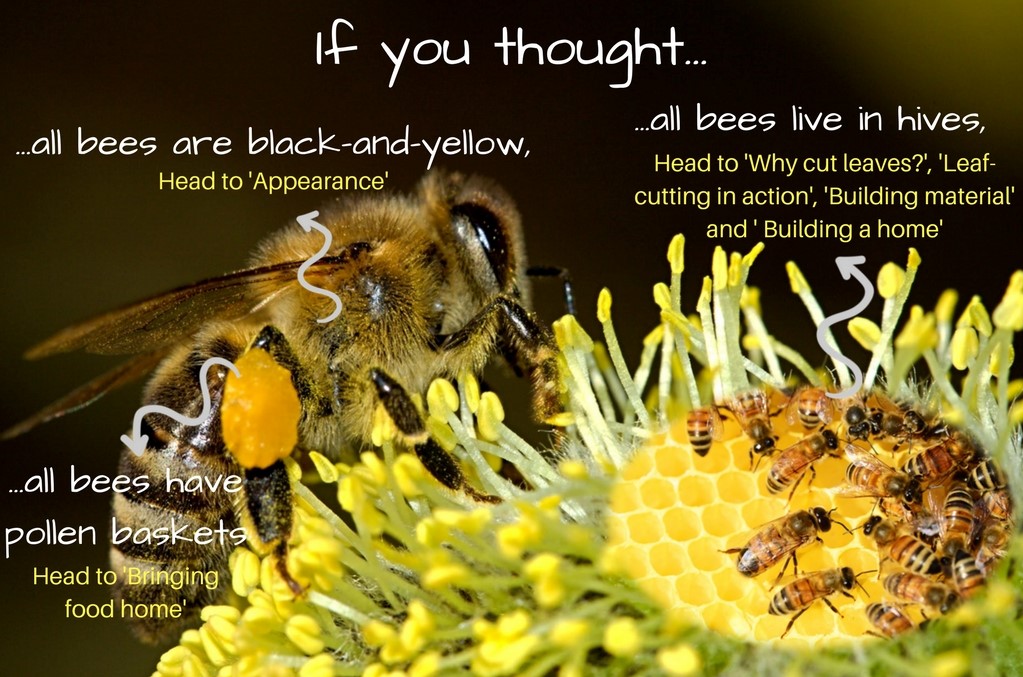 |
| Figure 5. Western honeybee. Images used under Creative Commons (CC0) license. |
Introduction
The family Megachilidae is a group of bees known as leaf-cutter or resin bees. Megachilidae is the second largest bee family after Apidae (which contains honey bees, carpenter bees and stingless bees) [4]. As their names suggest, leaf-cutter bees collect whole or cut leaves to line brood cells, while resin bees gather plant resins to line cells [6][7][8]. Unlike honey bees which live in colonies, leaf-cutter bees are solitary and do not aggressively defend nesting areas [9].
Why cut leaves?
The nesting biology of leaf-cutter bees is one of the most fascinating aspects of its behaviour. Provisions in nests have to be protected from spoilage from fungus [10][11], and at the same time, there is also a need to defend larvae from predation and parasitism [12][13]. The solution to these problems is thus to line brood cells in pre-existing cavities with hydrophobic material to prevent provision spoilage and minimise predation risk [12][14][11].
While many bees secrete a hydrophobic lining, through the Dufour’s gland, to coat the interior of the brood cells [15], Megachilid bees use a wide variety of materials to line their cells, such as mud, cement, petals or leaves (intact or chewed) [7][16]. These foreign materials used by megachilids are hydrophobic and contain secondary compounds that have antimicrobial properties [8][11][10]. This special adaptation of using of foreign materials in nest building may have allowed Megachilids to diversify and expand their ranges within the family [7]. In particular, certain subgenera of Megachile, including Aethomegachile which M. laticeps belongs to, cut intact leaf pieces for use in nest-building [4]. Some examples Megachilid nests are shown below.
| Figure 6. M. atrata nest at the side of a lobster mound, using cut leaf pieces. Image by Eunice Soh [2], used with permission. |
| Figure 7. M. fulvipennis nesting in a cavity in a wooden bench, lined with resin and pieces of wood. Image by Eunice Soh [2], used with permission. |
Leaf-cutting in action
How do leaf-cutter bees obtain their material for nest-building? Watch a leaf-cutter bee in action as it uses its mandibles to chew a circular piece out of a leaf.
Moreover, there is an art to leaf-cutting by these bees! Typically, leaf pieces used to construct cell walls and bases are oblong, while cell closures are circular [4]. Notice how they typically begin cutting from leaf margins, and do not begin cutting from previous damage despite sufficient leaf width [17]. While herbivory damage on leaves are common, cuts on leaves caused by leaf-cutter bees can be differentiated from those caused by other insects from their unique circular shape.
 |
| Figure 8. Examples of leaves cut by Megachile spp. Oblong cuts are pointed out in red arrows while circular cuts are pointed out in yellow arrows. Images by Sebastian Ow, used with permission. |
Building material
Megachile are able to utilise a wide range of leaf resources in building their nests, where field observations of cut leaves in one study in Singapore found at least 48 species of plants from 17 families [2]. In India, one study found that the bees collected leaves from 59 species of plants from 25 families [17]. These bees do not seem to be picky about leaf sizes, morphotypes and plant habits [17].
| Figure 9. Percentage of plants by family used as resources for nest-building by Megachile in Singapore. Image by Eunice Soh [2], used with permission. |
In two separate studies of leaf preferences by Megachile conducted on different continents, both found a similar diversity of plant resources utilised by the bees in nest-making, although there was little plant species overlap between the studies [8][17]. This suggests selection of plant species by Megachile is likely driven by local plant diversity [17]. Nevertheless, mechanical and antimicrobial properties of leaves are likely to be important in informing leaf choice for nest-building [8].
Although leaf species collected varied significantly across Megachile species, there was no preference for native or exotic plant species [8]. In fact, the abundance of exotic plant species in urban environments could provide a greater diversity of nest material for leaf-cutter bees [18][19].
Building a home
After obtaining their building materials, how are they used in nest-building? Check out this video of a leaf-cutter bee building its nest!
Nest of Megachile laticeps
Trap-nesting using bamboo internodes in Singapore revealed the nest biomics of M. laticeps. Individual cells are aligned linearly, with each wrapped in leaves and one outer layer of interlocking leaves between cells [2]. Nests are sealed with circular leaf pieces [2].
| Figure 10. Complete nest of M. laticeps (5 cells); circular cell caps are shown on the right. Images by Eunice Soh [2], used with permission. |
Leaf-cutter bees bring back provisions for developing larvae in the form of pollen [2]. Each cell contains a mud layer at the bottom and an upper layer of orange-coloured pollen mass, along with a single egg [2][9].
| Figure 11. Structure of a single cell (A, B, C) and leaf pieces taken apart from one cell (D). Image by Eunice Soh [2], used with permission. |
The figure below shows a cocoon spun by a post-defecating larvae, as well as a circular leaf cap bearing a chewed hole by an emerging adult male [2].
| Figure 12. Post-defecating larvae of M. laticeps. Image by Eunice Soh [2], used with permission. |
Who else is home?
Coelioxys (Callosarissa) confusa was found to be a kleptoparasite of Megachile laticeps, stealing food that M. laticeps has collected by laying its own eggs in M. laticep’s nest [2].
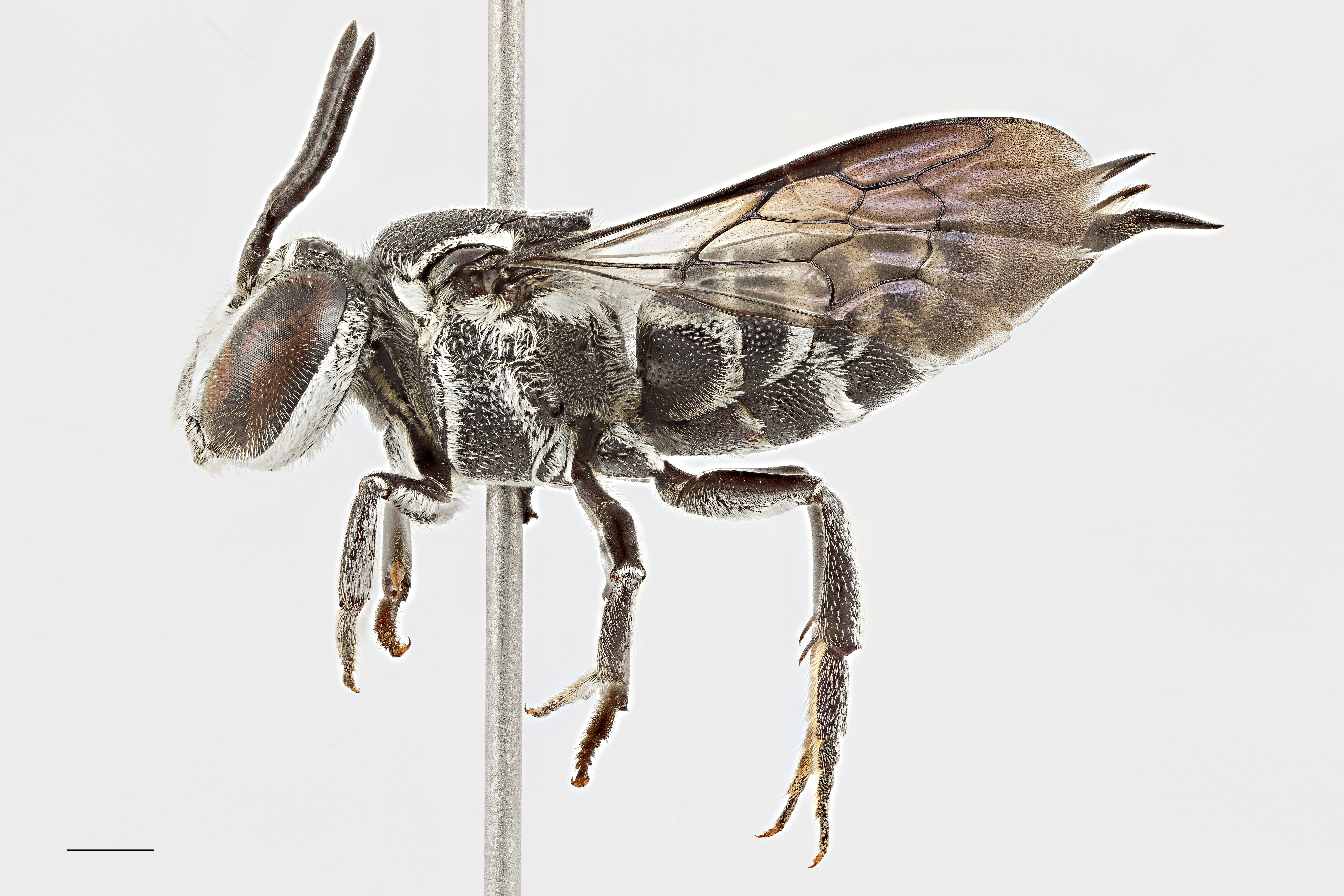 |
| Figure 13. Coelioxys confusa. Image by Chui Shao Xiong, property of NUS Insect Diversity Lab, used with permission. |
Other organisms that have been found in its nest included tachinid fly pupae and microlepidoptera larvae [2]. These organisms, however, were not observed to directly affect bee mortality, so they may merely be inquilines, i.e. living in the nest of other species [2]. However, other flies such as conopids are known parasitoids (living in the bee and eventually killing the host) of Megachile, so the effect of their presence remains to be seen [20].
| Figure 14. Other organisms found in nest of M. laticeps: microlepidoptera larva (A), tachinid fly (B), Images by Eunice Soh [2], used with permission. |
Bringing food home
Pollen transport
Megachilids transport pollen in a unique way – through hairs called scopae located on their bellies, under their abdomen (metasoma) [21]! This feature is unique to Megachilidae and can be used to distinguish them from other bee families. On the other hand, honeybees and bumblebees carry pollen in baskets known as corbiculae, which are made of dense hairs woven together to form a concave shape [4]. Many other bees do not have pollen baskets, but specialised long or sticky hairs called scopae on their legs [4].
| Metasoma |
Pollen basket |
Scopae on leg |
||||||
|
|
|
||||||
| Leaf-cutter bee (M. laticeps) collecting pollen. Check out the pollen on scopae under the abdomen! |
Asian honeybee (Apis cerana) collecting pollen with a pollen basket. |
True long-horned bee (Melissodes trinodis) with long hairs on its hind leg that allow it to carry pollen. |
The table below summarises the modes of pollen transport by different families of bees, where Megachilidae almost exclusively transports pollen through the metasoma.
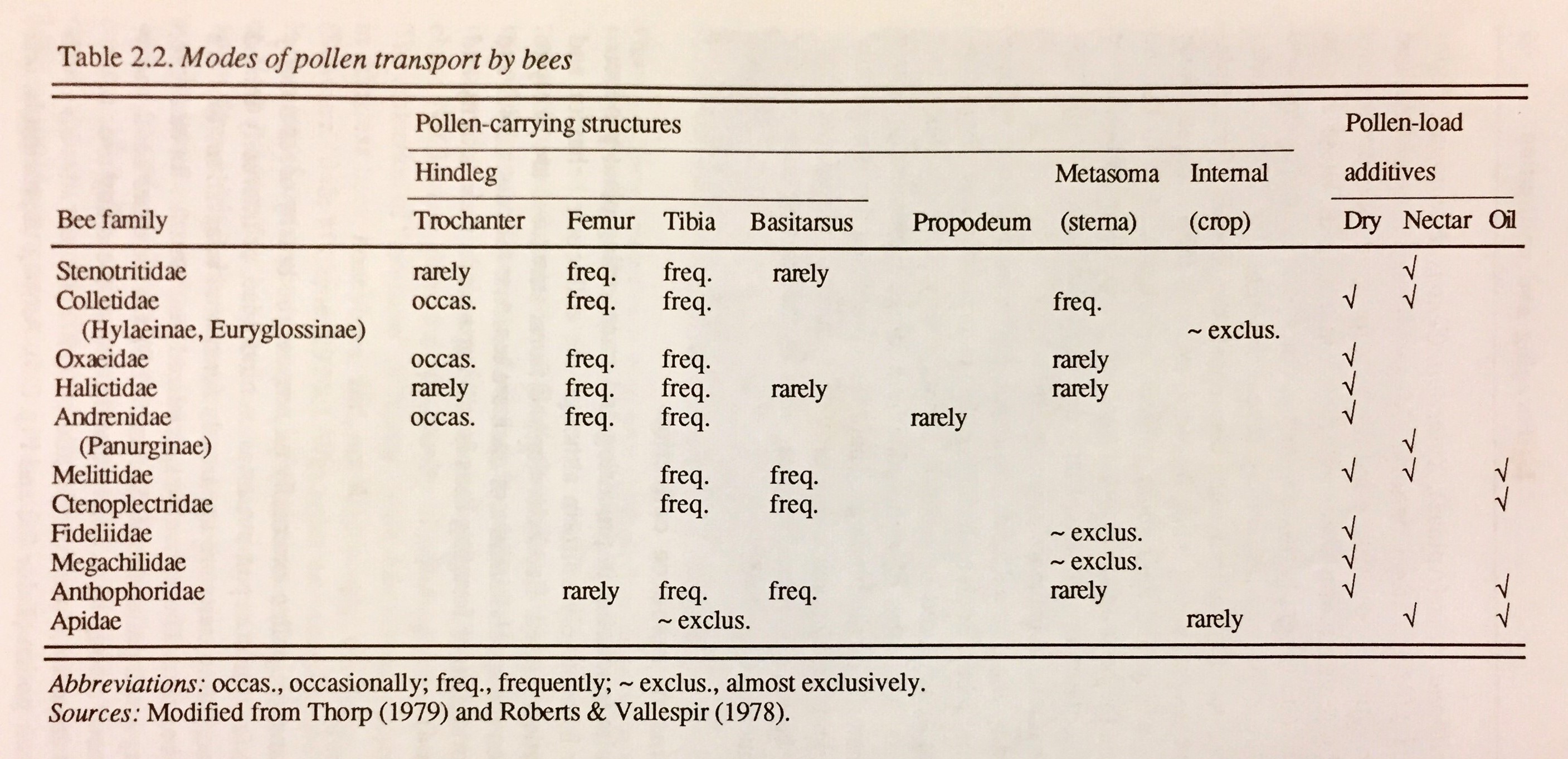 |
| Figure 18. Table showing different modes of pollen transport, where Megachilidae almost exclusively uses metasoma for pollen transport. Table from Roubik, 1989 [21], fair use. |
Food sources
Like most Megachile in Singapore, Megachile laticeps is polylectic, meaning that it is non-specialist in collecting pollen from different plant groups [2]. M. laticeps has been observed collecting pollen from Crotalaria pallida, Peltophorum pterocarpum (Fabaceae), Memecylon caeruleum (Melastomataceae), and Vitex trifolia (Lamiaceae) [1].
|
|
Appearance
The diversity in external morphology among Megachile species is stunning, a far cry from the typical black-and-yellow honeybee we imagine when we think of bees! Just check out some of the Megachile that can be found in Singapore:
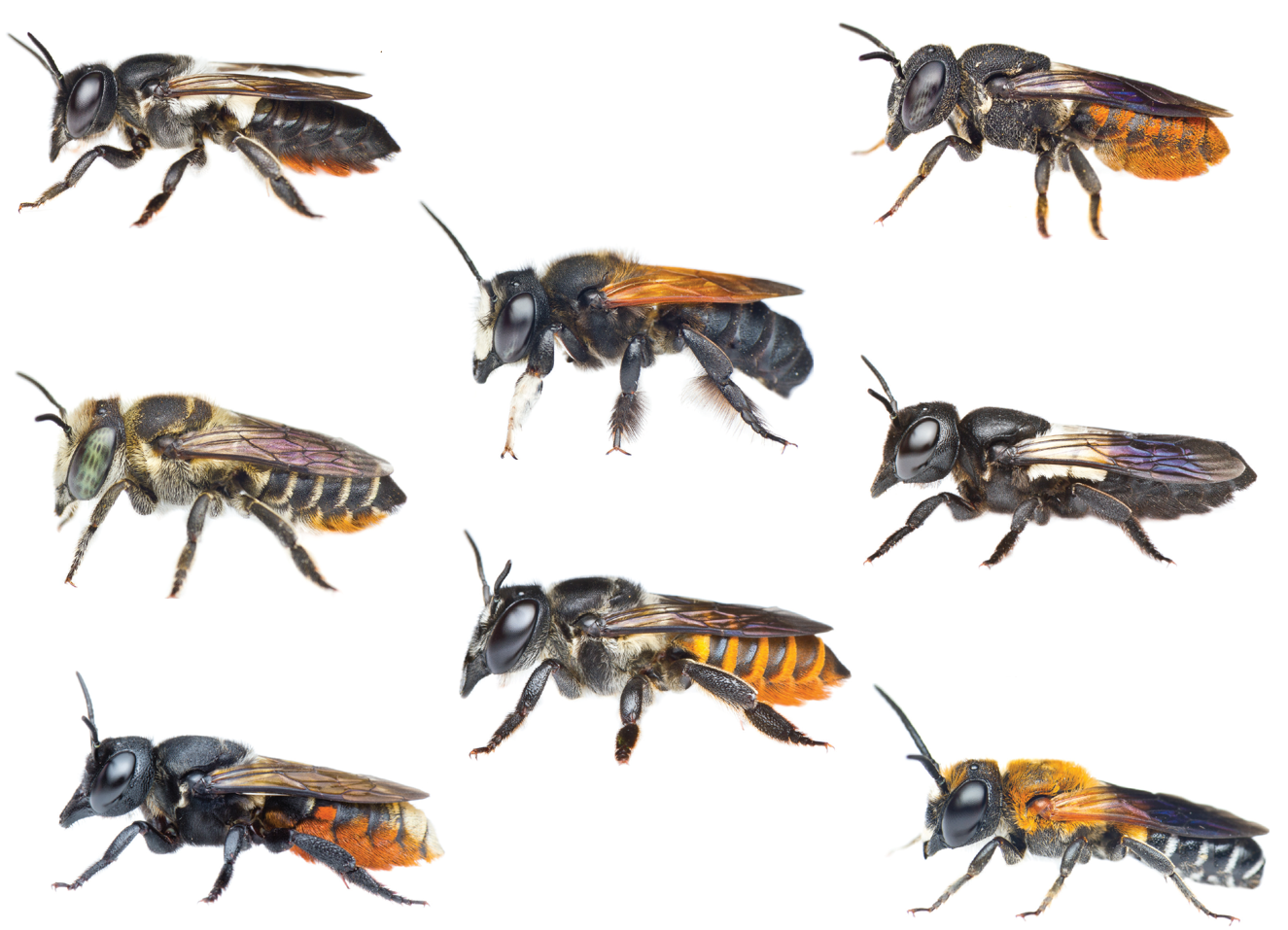 |
| Figure 21. Some Megachile species found in Singapore. Images from Ascher et al. (2016) [1], used with permission. |
Megachile species in Singapore appear to mimic each other, to their mutual benefit, such that predators learn to avoid distasteful species that look alike (a phenomenon known as Mullerian mimicry) [1]. This makes species identification a challenge. In general, Megachile in Singapore can be divided into three groups based on their morphology [2]:
1. Black-and-orange metasoma
2. Black-and-white metasoma
3. Black habitus with orange wings
Megachile laticeps belongs to the first group, which is characterised by orange hairs on the head, thorax and anterior metasoma and pale apical bands on the tergum [1].
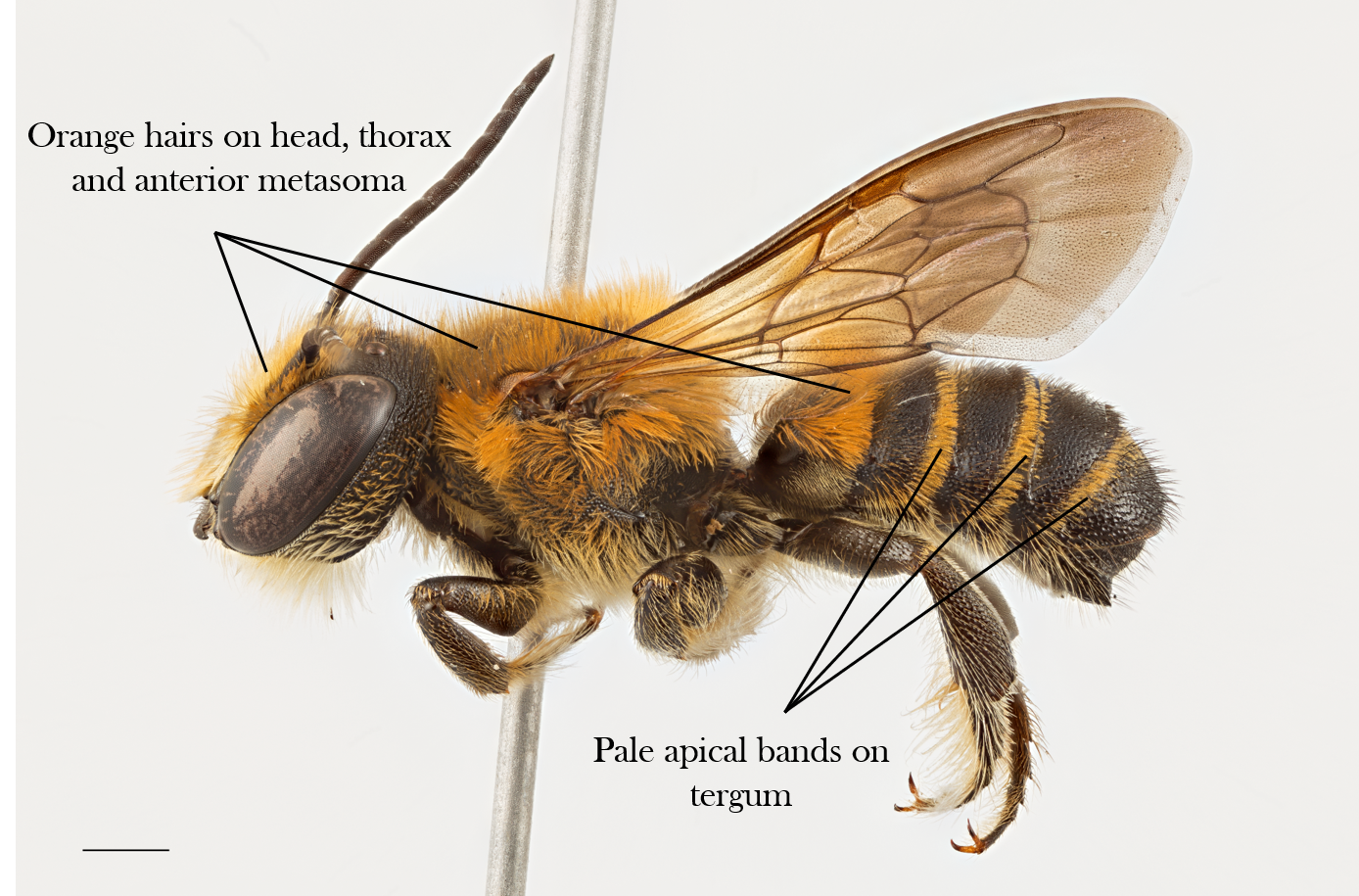 |
| Figure 22. Image by Chui Shao Xiong, property of NUS Insect Diversity Lab, used with permission (with annotations added). |
There are two other species of Megachile in Singapore that look similar to M. laticeps. The table below shows some distinguishing features that can be used to tell the species apart (Figure 23. All images by Eunice Soh, used with permission).
| Species |
Megachile (Aethomegachile) laticeps |
Megachile (Callomegachile) umbripennis |
Megachile (Aethomegachile) conjuncta |
|
| Photo |
||||
| Size (Total length in mm) |
♀: 11.8; ♂: 7.4-10.2 |
♀: 8.4-10.7; ♂: 7.2-8.8 M. umbripennis is noticeably smaller in size compared to the 2 other species. |
♀: 11.9; ♂: 9.2 |
|
| Genitalia |
||||
| Males of M. laticeps and M. conjuncta can be told apart by their genitalia morphology, where the diagnostic features are pointed out in black arrows. |
||||
Distribution
Megachile laticeps is one of the most widespread Megachile species in recent surveys of bees in Singapore [1]. Historically, it was first sampled in Singapore in 1977, and it is presumed to be a native species [1]. This is unlike other common species in recent years such as M. disjuncta, which was only first sampled in Singapore in 2010, suggesting that it may have been introduced locally from the dryer regions of Southeast Asia rather than being a true Singaporean native [1].
Megachile species in Singapore display differing habitat associations between species, with some only occurring in primary and secondary forests such as M. borneana and M. ornata [1]. On the other hand, M. laticeps occupies truly urban habitats on top of forest edges, parks and gardens [1]. M. laticeps is known to occur in all habitat types in Singapore except freshwater swamp forests [1].
| Figure 24. Distribution of M. laticeps in Singapore. Image from Ascher et al., 2016 [1], used with permission. |
Megachile laticeps is a predominantly Asian species, but has been presumably introduced to several oceanic islands and even as far as Hawaii, United States [1]. In the map below, blue markers show the native range while red markers show the introduced range of M. laticeps.
Taxonomy
What’s in a name?
The genus name Megachile is derived from the Greek word mega meaning ‘large’ and cheil meaning ‘lips’, with reference to the mouthparts of the leafcutter bees [22]. On the other hand, the species name laticeps means wide-headed, derived from the Latin, where latus means ‘broad’ and suffix ceps means ‘head’ [23]. This is why Megachile laticeps is also less commonly known as the Broad-headed Leaf-cutter Bee [5].
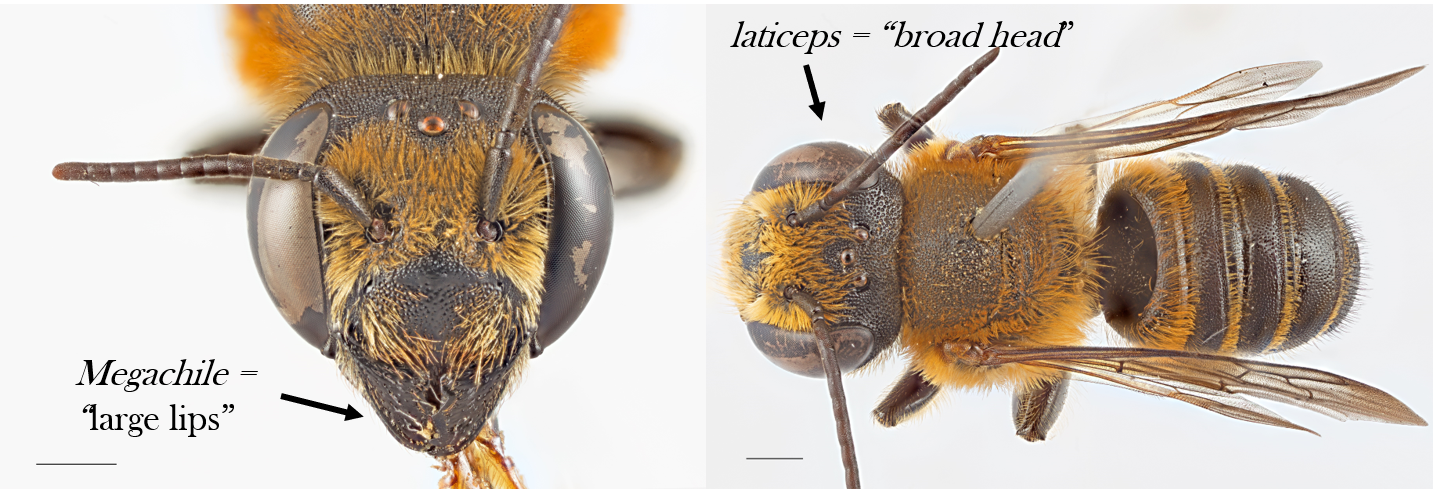 |
| Figure 25. Frontal and top view of M. laticeps. Images by Chui Shao Xiong, used with permission (with annotations added). |
Synonyms
Synonyms exist when different names are given to the same species, usually as a result of a scientist mistakenly describing a specimen as a new species when the same species has already been previously described. However, since Megachile laticeps is the first published name given to the species, it is recognised as the senior synonym and is the currently accepted name for the species.
Below is a list of synonyms of Megachile laticeps [5]:
Megachile cinyras Cameron, 1902
Megachile otriades Cameron, 1902
Megachile caecina Cameron, 1903
Megachile gadara Cameron, 1903
Megachile robbii Ashmead, 1904
Megachile semperi Friese, 1905
Megachile varidens Cameron, 1905
Megachile roepkei Friese, 1914
Megachile metallescens Cockerell, 1918
Megachile mcgregori Cockerell, 1918
Megachile penangensis Cockerell, 1918
Megachile subignita Cockerell, 1918
Megachile laticeps Smith, 1853
Species description
First described by Frederick Smith in 1853 from a specimen in the Philippines Islands, the type specimen is kept in the British Museum (Natural History), Department of Zoology [24].
| Figure 26. Screenshot of original species description. Taken from Smith, 1853 [24], fair use. |
Higher Classification
Kingdom: Animalia
Phylum: Arthropoda
Class: Insecta
Order: Hymenoptera
Family: Megachilidae
Subfamily: Megachilinae
Tribe: Megachilini
Genus: Megachile Latreille, 1802
Species: Megachile laticeps Smith, 1853
The subgenus Aethomegachile was first named and described in 2006 by Engel and Baker [25]. In a recent treatment, Ascher et al. (2016) placed M. laticeps in this subgenus [1].
Phylogeny
Phylogenetic relationships within many large bee clades are poorly understood. Traditionally, Megachilidae has been divided into two morphologically and behaviourally unique subfamilies, namely Fideliinae and Megachilinae [4]. One of the first attempts to construct phylogenetic relationships between lineages of Megachilidae using molecular markers was conducted by Litman et al. in 2011 [7]. In the study, four protein-coding genes and one ribosomal gene were sequenced and phylogenetic analyses were performed using maximum-likelihood and Bayesian methods.
The monophyly of the family Megachilidae was confirmed; however, the tribes Fideliini and Osmiini were found to be paraphyletic. The tribe Megachilini (in red in the tree below), which Megachile belongs to, was found to be a monophyletic group with a maximum-likelihood bootstrap value of 100.
| Figure 27. Fossil-calibrated maximum clade credibility tree for bee family Megachilidae. Taken from Litman et al., 2011 [7], fair use. |
Gonzalez et al. (2012) examined relationships between tribes in Megachilidae based on adult morphology [16]. They coded 200 characters from all parts of the body and built a data matrix. Subsequently, they conducted Parsimony analysis and produced a strict consensus tree. M. laticeps belongs to tribe Megachilini (blue box in the figure below). Many of the branches have low bootstrap values, indicating poor support for the nodes. Nevertheless, the results of this study using morphological characters agree with findings from Litman et al. (2011) on the recognition of four subfamilies of Megachilidae (labelled nodes on the left in the tree below).
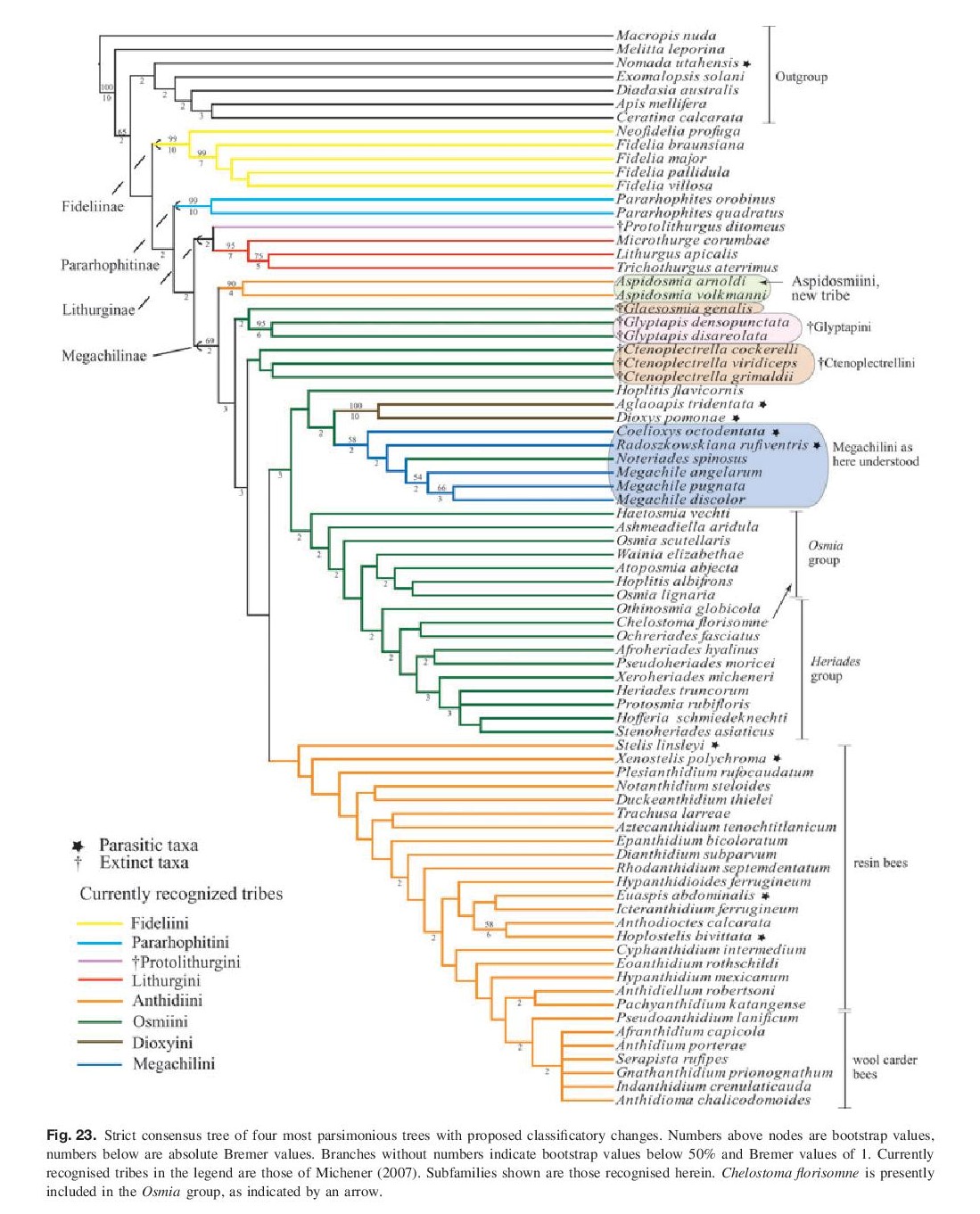 |
| Figure 28. Strict consensus tree showing relationships within the genus Megachile. Taken from Gonzalez et al., 2012 [16], fair use. |
Recently, Trunz et al. (2016) attempted to resolve relationships within the tribe Megachilini, in particular between the subgenera of the genus Megachile [26]. Using mitochondrial DNA barcodes together with nuclear phylogeny, a matrix was created and analysed using maximum-likelihood and Bayesian inferences [26]. All subgenera appear monophyletic and majority have high statistical support [26]. The position of M. laticeps is marked out in a red star in the tree below. The recent placement of M. laticeps in the new subgenus Aethomegachile by Ascher et al. (2016) was confirmed by this study, where M. laticeps clustered with other species, such as M. conjuncta, placed in this subgenus [26].
The results of this study suggest that while relationships within subgenera are well-supported, classification between the three groups of subgenera are more challenging to resolve (see next section on groupings of subgenera). In particular, morphology-based classification proposals to divide Group 2 subgenera into genera were not supported. This suggests that there still exists disagreement on the above-species level classification of Megachile.
 |
| Figure 29. Combined nuclear + barcode analysis for Megachilini. Taken from Trunz et al., 2016 [26], fair use. |
Ranks above species level
For ranks to be useful, they should reflect equivalence of groups on the tree of life, such as by reflecting hierarchy, age of clade, species diversity or morphological or genetic diversity. From the fossil-calibrated tree (Figure 27), we can observe that the subfamilies and tribes of Megachilidae are dissimilar with regard to age of clade, as evidenced by the emergence of the nodes at different time periods. Among subfamilies, Pararhophitinae and Lithurginae include only one tribe each, while Megachilinae is highly diverse and contains four species-rich tribes [27], suggesting that subfamilies do not reflect equivalence in species diversity either.
Furthermore, the division of genera and subgenera also appear to be arbitrary and unresolved. While most authors originally recognised several subgenera, they had placed bees in the genus Megachile in a single genus, until Michener (1962) recognised the great differences between the subgenera and divided the genus into 3 genera [3]. Some authors consider Group 1, 2 and 3 to correspond to the genera Megachile, Chalicodoma and Creightonella [28][29][30], while others have proposed to divide some groups into multiple genera [4][31].
However, in an updated version of his book The Bees of the World, Michener (2007) acknowledged the presence of intermediates, where there were species that were as different as genera among other bees [4]. He then placed subgenera of Megachile into three different groups (see table below), refraining from recognising distinct genera due to similarities in morphology across groups. Most leafcutters belong to Group 1, where Aethomegachile belongs, although it is absent in the table due to it being a relatively new genus at that point in time.
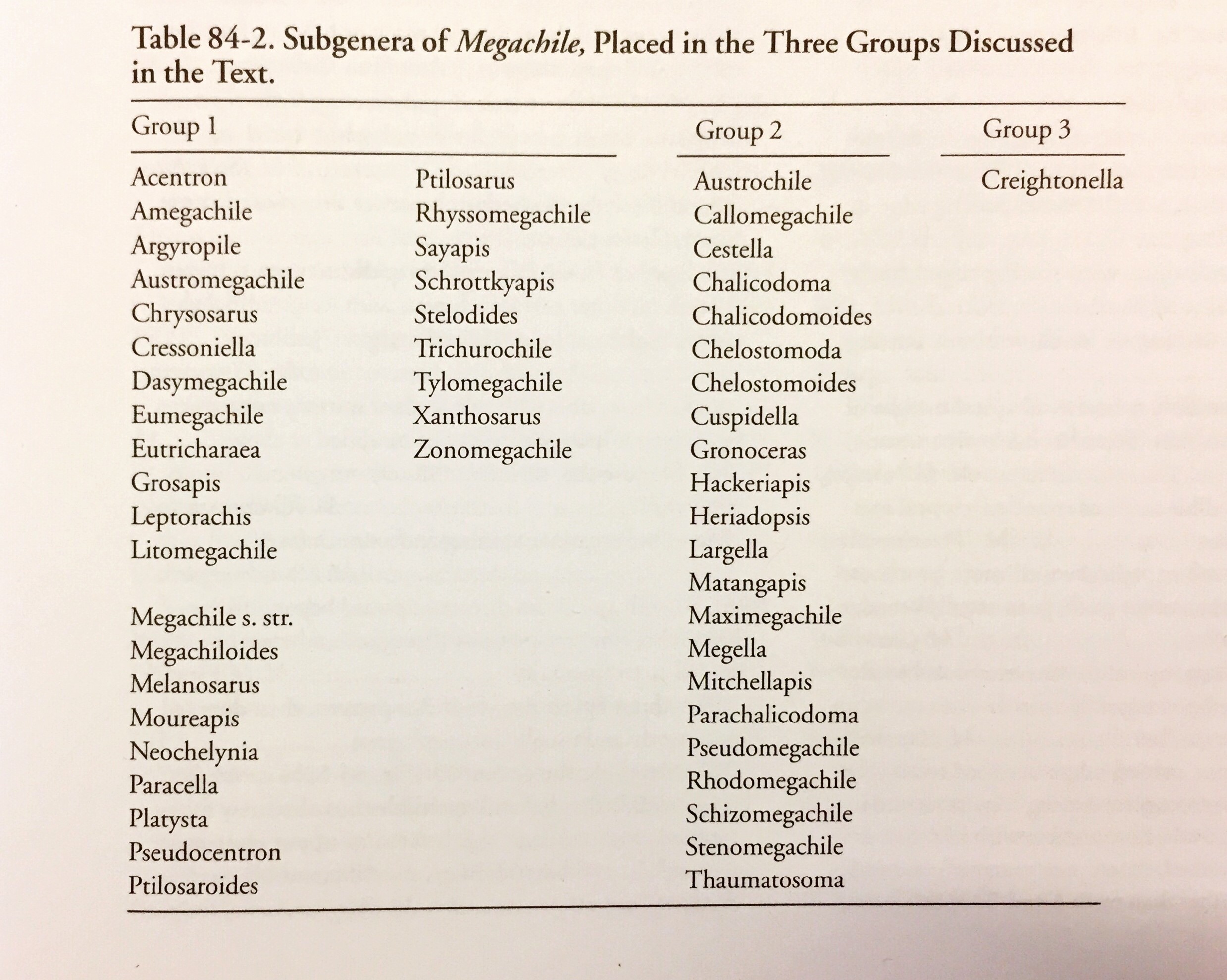 |
| Figure 30. Table showing groups of subgenera of Megachile. Taken from Michener, 2007 [4], fair use. |
Hence, in the case of the Megachilidae, the familial, sub-familial, tribal, generic and sub-generic ranks appear to be largely uninformative and arbitrary, where major disagreements exist over the classification of ranks. Nevertheless, currently-recognised ranks and taxon names are used here as they are in literature for convenience and coherence.
References
[1] Ascher, J. S., Risch, S., Soh, Z. W., Lee, J. X., & Soh, E. J. (2016). Megachile leaf-cutter and resin bees of Singapore (Hymenoptera: Apoidea: Megachilidae). Raffles Bulletin of Zoology.
[2] Soh, E. J. Y. (2014). Diversity and trap-nesting studies of Singaporean Megachile bees to inform monitoring and management of tropical pollinators (B. Sc. thesis, Department of Biological Sciences, National University of Singapore, Singapore).
[3] Michener, C. D. (1962). Observations on the classification of the bees commonly placed in the genus Megachile (Hymenoptera: Apoidea). Journal of the New York Entomological Society, 17-29.
[4] Michener, C. D. (2007). The Bees of the World. 2nd. Ed. Johns Hopkins, Baltimore.
[5] Ascher, J. S., & Pickering J. (2017) Discover Life Bee Species Guide and World Checklist (Hymenoptera: Apoidea: Anthophila). Discover Life, University of Georgia, USA. Retrieved from: http://www.discoverlife.org/mp/20q?guide=Apoidea_species (Accessed on 15 Nov 2017).
[6] Wedmann, S., Wappler, T., & Engel, M. S. (2009). Direct and indirect fossil records of megachilid bees from the Paleogene of Central Europe (Hymenoptera: Megachilidae). Naturwissenschaften, 96(6), 703-712.
[7] Litman, J. R., Danforth, B. N., Eardley, C. D., & Praz, C. J. (2011). Why do leafcutter bees cut leaves? New insights into the early evolution of bees. In Proc. R. Soc. B(Vol. 278, No. 1724, pp. 3593-3600). The Royal Society.
[8] MacIvor, J. S. (2016). DNA barcoding to identify leaf preference of leafcutting bees. Royal Society open science, 3(3), 150623.
[9] Serrano, D. (2005). Leafcutting bees - Megachilidae. Featured Creatures. Retrieved from http://entnemdept.ufl.edu/creatures/misc/bees/leafcutting_bees.htm
(Accessed 15 Nov 2017).
[10] Müller, A., Topfl, W., & Amiet, F. (1996). Collection of extrafloral trichome secretions for nest wool impregnation in the solitary bee Anthidium manicatum. Naturwissenschaften, 83(5), 230-232.
[11] Messer, A. C. (1985). Fresh dipterocarp resins gathered by megachilid bees inhibit growth of pollen-associated fungi. Biotropica (USA).
[12] Eltz, T., Küttner, J., Lunau, K., & Tollrian, R. (2015). Plant secretions prevent wasp parasitism in nests of wool-carder bees, with implications for the diversification of nesting materials in Megachilidae. Frontiers in Ecology and Evolution, 2, 86.
[13] Krunić, M., Stanisavljević, L., Pinzauti, M., & Felicioli, A. (2005). The accompanying fauna of Osmia cornuta and Osmia rufa and effective measures of protection. Bulletin of Insectology, 58(2), 141-152.
[14] Cane, J. H., Gerdin, S., & Wife, G. (1983). Mandibular gland secretions of solitary bees (Hymenoptera: Apoidea): potential for nest cell disinfection. Journal of the Kansas Entomological Society, 199-204.
[15] Hefetz, A. (1987). The role of Dufour's gland secretions in bees. Physiological Entomology, 12(3), 243-253.
[16] Gonzalez, V. H., Griswold, T., Praz, C. J., & Danforth, B. N. (2012). Phylogeny of the bee family Megachilidae (Hymenoptera: Apoidea) based on adult morphology. Systematic Entomology, 37(2), 261-286.
[17] Kambli̇, S. S., Aiswarya, M. S., Manoj, K., Varma, S., Asha, G., Rajesh, T. P., & Sinu, P. A. (2017). Leaf foraging sources of leafcutter bees in a tropical environment: implications for conservation. Apidologie, 48(4), 473-482.
[18] Fortel, L., Henry, M., Guilbaud, L., Guirao, A. L., Kuhlmann, M., Mouret, H., ... & Vaissière, B. E. (2014). Decreasing abundance, increasing diversity and changing structure of the wild bee community (Hymenoptera: Anthophila) along an urbanization gradient. PloS one, 9(8), e104679.
[19] Threlfall, C. G., Walker, K., Williams, N. S., Hahs, A. K., Mata, L., Stork, N., & Livesley, S. J. (2015). The conservation value of urban green space habitats for Australian native bee communities. Biological Conservation, 187, 240-248.
[20] Cardoso, C. F., & Silveira, F. A. (2012). Nesting biology of two species of Megachile (Moureapis)(Hymenoptera: Megachilidae) in a semideciduous forest reserve in southeastern Brazil. Apidologie, 43(1), 71-81.
[21] Roubik, D. W. (1992). Ecology and natural history of tropical bees. Cambridge University Press.
[22] Revolvy (2017). Megachile zombie. Retrieved from https://www.revolvy.com/main/index.php?s=Megachile%20zombae&uid=1575 (Accessed on 15 Nov 2017)
[23] Bester, C. (2017). Cephaloscyllium laticeps. Retrieved from https://www.floridamuseum.ufl.edu/fish/discover/species-profiles/cephaloscyllium-laticeps/ (Accessed on 15 Nov 2017)
[24] Smith, F. (1853). Catalogue of hymenopterous insects in the collection of the British museum. order of the Trustees.
[25] Engel, M. S., & Baker, D. B. (2006). A remarkable new leaf-cutter bee from Thailand (Hymenoptera: Magachilidae). Beiträge zur Entomologie= Contributions to Entomology, 56(1), 69-74.
[26] Trunz, V., Packer, L., Vieu, J., Arrigo, N., & Praz, C. J. (2016). Comprehensive phylogeny, biogeography and new classification of the diverse bee tribe Megachilini: Can we use DNA barcodes in phylogenies of large genera?. Molecular phylogenetics and evolution, 103, 245-259.
[27] Danforth, B. N., Cardinal, S., Praz, C., Almeida, E. A., & Michez, D. (2013). The impact of molecular data on our understanding of bee phylogeny and evolution. Annual review of Entomology, 58, 57-78.
[28] Michener, C. D. (1965). A classification of the bees of the Australian and South Pacific regions. Bulletin of the AMNH; v. 130.
[29] Pasteels, J. J. (1965). Revision des Megachilidae.(Hymenoptera apcidea) de l'Afrique noire.
[30] Tkalcu, B. (1969). Beitrage zur Kenntnis der Fauna Afganistans– Chalicodoma Lep. Megachilidae. Apoidea. Act. Mus. Morav. Sci. na, 54, 347-384.
[31] Mitchell, T. B. (1980). A generic revision of the megachiline bees of the Western Hemisphere. Department of Entomology, North Carolina State University, Raleigh NC, USA.

